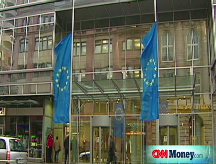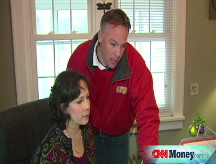Long-term Treasurys continue to rally
Government debt remains in demand as investors respond to aggressive new steps by the Federal Reserve.
NEW YORK (CNNMoney.com) -- Prices for long-term U.S. Treasury bonds rose Wednesday, keeping yields at historic lows, as investors digested unprecedented moves by the Federal Reserve.
On Tuesday, the U.S. central bank cut its key interest rate to a target range between 0% and 0.25%. The rate, which had been 1%, has never been this low and is now the lowest in the industrialized world.
Interest rate cuts are the Fed's main tool for boosting economic activity. But at such historically low levels, there is little room left for the central bank to maneuver.
As a result, the Fed is now exploring alternative ways to revive the ailing economy, including buying large amounts of Treasurys.
"The focus of the Committee's policy going forward will be to support the functioning of financial markets and stimulate the economy through open market operations and other measures that sustain the size of the Federal Reserve's balance sheet at a high level," the central bank wrote in a statement released on Tuesday.
While the Fed's description of these new measures was "very gray," the market now appears to be displaying "the results of the open-market operations," said Bill Larkin, a fixed-income specialist at Cabbot Money Management in Boston.
Many analysts warn, however, that the Fed's aggressive moves could have negative repercussions: One main concern is inflation, which is often a byproduct of lower interest rates.
"At some point inflation is going resurface," Larkin said.
Rising prices can severely erode the value of fixed-income investments like Treasurys.
Meanwhile, the grim economic backdrop that inspired the Fed to take such drastic measures is fueling a flight to quality, according to Larkin. Treasurys are considered a safe haven, and investors often flock to them as an alternative to more risky assets, such as stocks, when economic conditions worsen.
"Investors are asking, why zero? What is the Fed seeing that's so bad?" he said.
The benchmark 10-year note rose 1-20/32 to 113-26/32, lowering its yield to 2.18% from 2.36% Tuesday. Bond prices and yields move in opposite directions.
The 30-year long bond jumped 5-11/32 to 137-19/32 and its yield fell to 2.65% from 2.86%.
The 2-year note dipped 5/32 to 100-31/32 and its yield rose to 0.74% from 0.65%.
Credit crisis: Separately, bank-to-bank lending rates fell further overnight.
The overnight Libor rate declined to 0.13% from 0.16% on Tuesday, while the 3-month Libor rate dropped to 1.58% from 1.85%, according to Bloomberg.com.
Libor, the London Interbank Offered Rate, is a daily average of what 16 different banks charge other banks to lend money in London, and is used to calculate adjustable-rate mortgages. More than $350 trillion in assets are tied to Libor.
Libor rates have come down significantly after a massive spike in October during the height of the credit crisis, as central banks worldwide have worked to inject liquidity into the global financial system.
But the difference between the Fed's rock-bottom rate and Libor highlights the ongoing troubles in credit markets, according to Kim Rupert, a fixed-income analyst at Action Economics.
"We've come down about halfway from where rates were when the problems were front page news. But the problems are still not fixed," Rupert said.
Still, the credit crisis has resulted in "a whole new world," she added. "It might be unrealistic to expect rates to go back to pre-crisis levels."
Despite the jitters, two key indicators suggest the market has some appetite for risk.
The "TED spread" narrowed to 1.57 percentage points from 1.81 percentage points Tuesday. The TED spread measures the difference between the 3-month Libor and the 3-month Treasury bill, and is a key indicator of risk. The higher the spread, the more unwilling investors are to take risks.
Another indicator, the Libor-OIS spread, shrank to 1.4 percentage points from 1.7 percentage points as the Overnight Index Swap rate fell to 0.19% from an opening level of 0.24% Tuesday.
OIS rates are set against the effective Fed funds rate, as opposed to the central bank's target rate or range. The Libor-OIS spread measures how much cash is available for lending between banks, and is used for determining lending rates. The bigger the spread, the less cash is available for lending. ![]()




